Game-changing the future
Overview
What is innovation and how does it occur? Technological advances are shaping and empowering consumers. We demand more, and better, for less. Forward thinking businesses are changing the way they operate to harness these new technologies and deliver value to their customers in new and interesting ways. They are not just innovating new products and services, but also the way they create and deliver that value to their customers. This is business model innovation.
Overview
Over the course of four publications we will examine the need for Australia to harness new technologies and trends to reverse a concerning decline in underlying productivity Part 1 – The need to innovate .
We will then introduce the Business Model Canvas, a template for identifying the drivers of value and innovation within a business Part 2 – What is business model innovation? .
In the third publication we will use the Business Model Canvas to identify and understand some emerging business models that leverage a number of key consumer trends Part 3 – The drivers and enablers of innovation .
In the final publication we will consider how companies should go about innovating and some of the risks associated with it Part 4 – How to innovate.

The need to innovate
Australia's Gross Domestic Income continues to grow. But in the most recent decade the drivers of growth have been capital investment and favorable terms of trade, and these have been primarily driven by the resources boom. Underlying productivity is, at best, stagnant. Australia faces a significant productivity challenge. But it will not be addressed through incremental efficiency gains. It will only be addressed through step change gains brought about by innovation. We need to shift our focus from doing more of the same, to finding new and innovative ways to create and deliver value.
The productivity challenge
Over the past 15 years Australia's Gross Domestic Income has increased, on average, by $30 billion per year, and the rate has been accelerating. But behind the headline numbers is a troubling story. Underlying growth is actually decreasing. We are becoming less productive as a nation. Innovation may be the only way to reverse the trend.
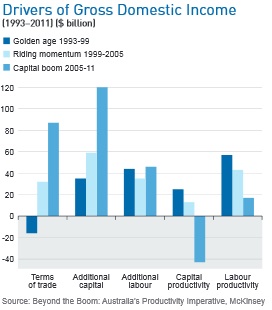
Whilst Australia's Gross Domestic Income has continued to increase during the 1990s, 2000s and since, the drivers of growth have shifted. Whist Capital and Labour productivity were key drivers of growth in 1993-99 ('the Golden Age') and 1999 – 2005 ('Riding Momentum'), both have significantly retreated in 2005-11 ('Capital Boom'). It has only been through a positive terms of trade and additional capital investment (driven by the resources boom), that Australia has been able to maintain the continuing increase in Gross Domestic Income.
Ten percent of the economy (the resources sector) has driven a third of recent income growth and more than half of the recent income growth has been due to the temporary effects of positive terms of trade and additional capital. 1
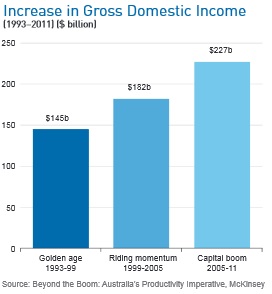
Whereas between 1999-2005 increases in labour productivity added $43 billion (measured in 2010 real terms) to national income, in the most recent period this has fallen by over 60% to only $17 billion.
The resources boom is already receding. If the underlying decline in labour and capital productivity is not corrected, the implications for future growth are profound.
A recent report by McKinsey (Beyond the Boom: Australia's Productivity Imperative) suggests future income growth could fall as low as 0.5% per annum if underlying productivity decline is not addressed.
McKinseys' modeling assumes a range of scenarios for terms of trade, investment, and capital and labour productivity. Under the 'Hangover' scenario (0.5% per annum growth), terms of trade returns to the long term average, only two thirds of advanced and one third of less advanced investment projects occur, and productivity stays at 2006–11 levels.
Productivity scenarios (2011–2017)
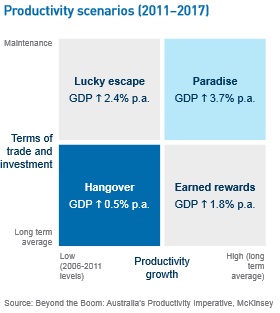
The outcome is sobering and the message is clear. If Australia wants to maintain growth rates commensurate with the past two decades, it must find ways to increase productivity returns to long term averages. 2
The innovation response
Australia's productivity challenge will not be addressed through incremental efficiency gains. Step change productivity is not about doing more with less. It's about producing things in fundamentally different ways. In short, it's about innovation.
Productivity is a measure of the ratio of inputs such as labour, materials and capital, to the production of outputs in the form of goods and services.
Too often, the indices of productivity are confused with the determinants of productivity. Traditional measures of productivity such as output per hours worked (labour productivity) or output per unit of labour and capital used (multi-factor profitability) are the scorecard. But they do not show how to achieve the goals.
The downward trend in national productivity suggests Australia is not as innovative as it needs to be. The message is sobering, but the opportunities that would flow from 'getting it right' are such that those who embrace the challenge may discover a profitable and sustainable future.
The most potent form of innovation is business model innovation. Business model innovation happens when firms find a whole new recipe for business success that changes the game.
True productivity is not about doing more with less, nor about working people harder for longer. Contrary to popular wisdom, productivity does not equate with efficiency; it centres on innovation and transformation – of business capabilities, skills, technology and competitiveness. It is focused on producing the same products and services in fundamentally different ways (delivering higher value at lower cost), or producing fundamentally different products and services for which there are no alternatives. 3
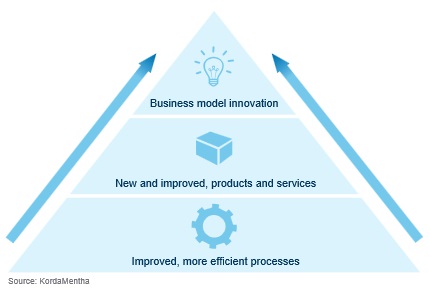
Why business model innovation matters
Process and product innovation alone are often not enough to generate value. Even the most innovative products often fail to fulfill their potential because they are unable to compete within the constraints of an existing business model. Shifts in the underlying model are often necessary to enable to innovative product or process to success in the marketplace. 4
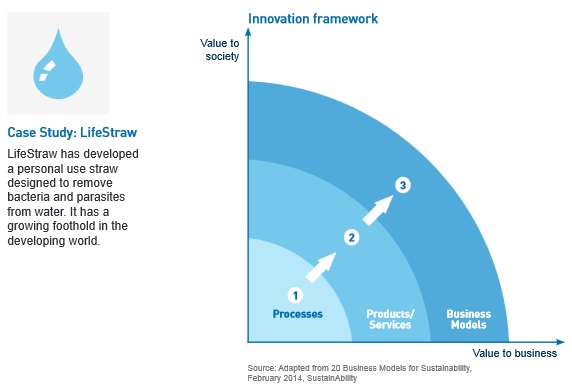
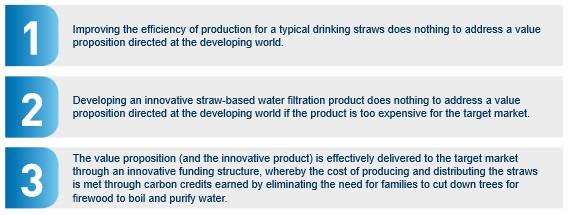
Engines of change
Business models – the underlying structures of how companies create, deliver and capture value – form the engine of business. What new engines will drive business in the future?
The evolution of power
The evolution of power

The inner workings of a business model, its products and processes, its interactions with stakeholders, what and how it measures, the transactions it requires, influence a company's ability to thrive in the future.
Business model innovation ultimately involves a novel form of exchange at some point along a company's value chain. When that exchange, sometimes completely new, other times just different, creates new value, or distributes value more equitably, then it may be considered innovative. 5
Challenging existing business models
Existing businesses are driven to innovate by one of four primary reasons – why innovate?.
Once prompted by one of these drivers, businesses typically focus on one of four routes to innovation – how to innovate?.
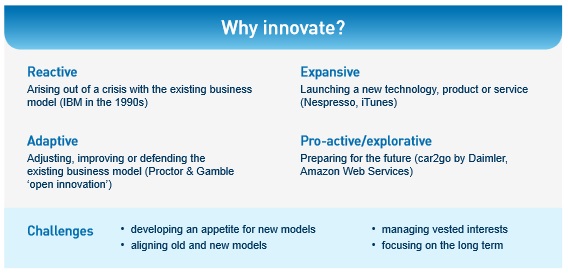
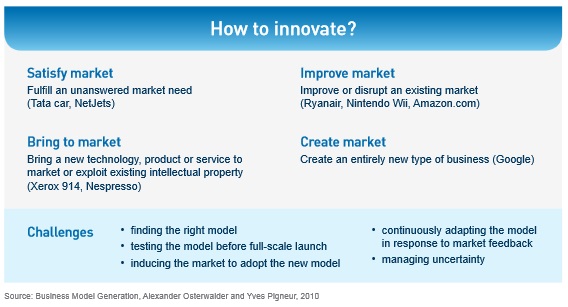
Looking forward
The business case for innovation is clear. Over the course of our next three publications we will introduce the Business Model Canvas and the concept of Blue Ocean Strategy to provide a framework for understanding innovation. We will then discuss some key enabling technologies and trends and use the framework to understand how innovative businesses are leveraging these to find new ways to create and deliver value.
Introducing the Business Model Canvas
If business models are the recipe for creating value, what are the ingredients? The Business Model Canvas is a visual framework comprising nine segments, or building blocks, that enable us to identify the key drivers of difference or innovation within an organisation.
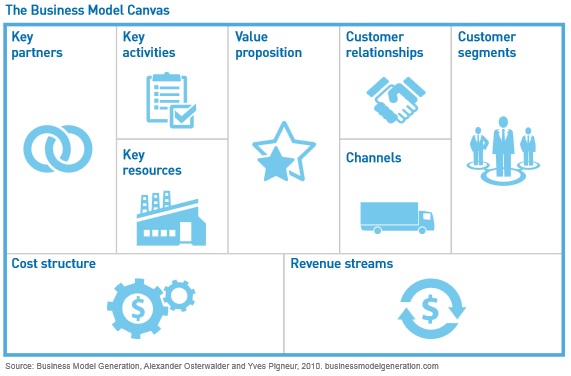
Acknowledgement
Our Business Model Innovation series of publications draws heavily on the Business Model Canvas. More information on this tool can be found at businessmodelgeneration.com
Blue Ocean Strategy
Blue Ocean Strategy dismisses the old dichotomy of competing on either price or value and provides a path to the creation of new value propositions that create new, uncontested markets.
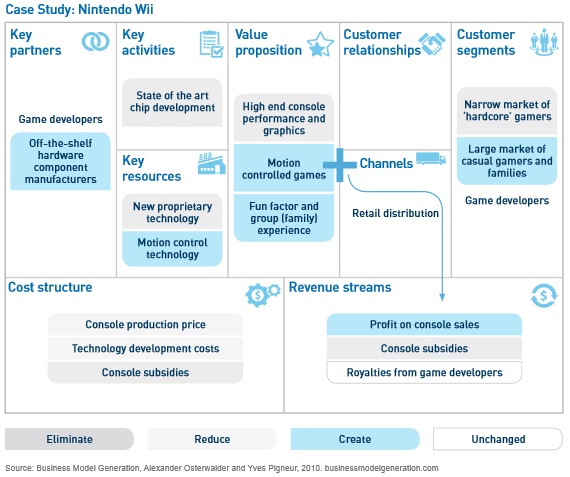
In our second publication we will show how Blue Ocean Strategy and the Business Model Canvas can be combined to break down and understand the innovative approach Nintendo adopted to allow the technologically inferior Wii to compete effectively against Sony's Playstation 3 and Microsoft's Xbox 360.
The drivers and enablers of innovation
In our third publication we will discuss key enabling technologies and trends and investigate how innovative businesses are leveraging these to find new ways to create and deliver value.
Drivers and enablers of innovation
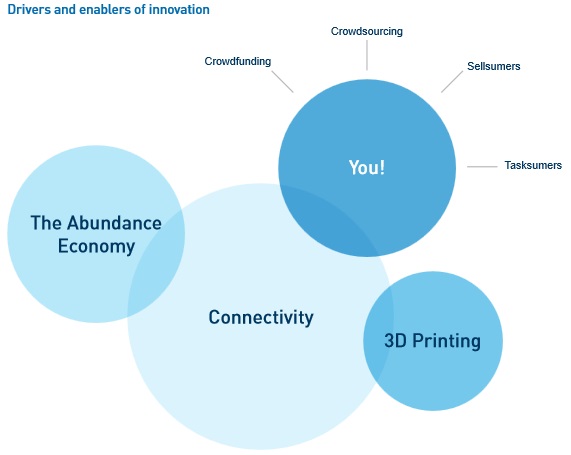

Notes
1 "Australia's incentive to lift
productivity: $90bn a year". Australian Financial Review, 16
August 2012. Web 15 February 2013
http://
www.afr.com/p/national/australia_incentive_to_lift_productivity_
PYYDnqYeG9wmvuwZsJLLyN
2 ibid
3 Manufacturing Futures, Australian Business Foundation
for the NSW Business Chamber, April 2011. Web 13 February 2013
http://www.nswbusinesschamber.com.au/NSWBC/media/Misc/Policy%20
Documents/NBC-515_Manufacturing_Futures_Paper.pdf
4 20 Business Models for Sustainability, February 2014,
SustainAbility. Web 9 April 2014 http://www.sustainability.com/library/attachment/470
5 ibid
The content of this article is intended to provide a general guide to the subject matter. Specialist advice should be sought about your specific circumstances.

